With its harsh desert vistas and simmering heat, Saudi Arabia is truly a land of the lizards.
Imagine a land with lizards so large and numerous that you can spot them from a speeding car as they pop up from their burrows. A country where lizards are so prevalent that they scatter away from your approaching footsteps like a school of lakeside minnows. If this tickles your lacertilian fancy, then you owe it to yourself to visit Saudi Arabia, a place where lizards rule.
Herping the Kingdom of Saudi Arabia
The largest country in the Middle East, the Kingdom of Saudi Arabia is a huge chunk of desert about one-fifth the size of the United States. It is bordered on the north by Iraq and Iran; Yemen and Oman round out its southern tip. To the east and west sit the strategic waterways of the Persian Gulf and the Red Sea. Ruled by King Abdullah, son of the first Saudi king, Saudi Arabia is truly a monarchy. The country is a predominately harsh desert with no running waterways or large permanent bodies of water. Summer temperatures regularly exceed 120 degrees Fahrenheit, and barely 2 percent of the country is arable. Yet with 20 percent of the world’s proven oil reserves, it is a country of enormous geopolitical and economic importance.
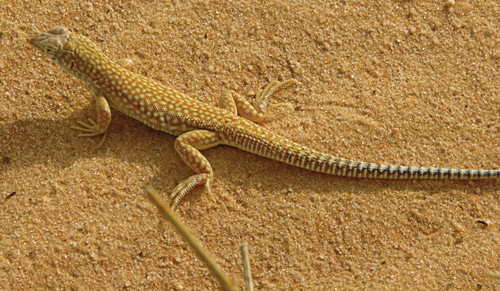
Photo by John M. Regan
Schmidt’s fringe-toed lizard (Acanthodactylus schmidti) can be distinguished by the exceptionally long fourth toe found on each of its rear feet.
There are at least 100 lizard species in Saudi Arabia, many perhaps unknown in the west. The Saudis are not known as great naturalists, and species identification is a challenge. Geckos of almost pure white emerge at night, and big pot-bellied geckos haunt wadi caves. Large desert monitors prowl the land as well. For any reptile enthusiast, Saudi Arabia is a potential treasure trove.
Transportation to Saudi Arabia
Transportation is not difficult, nor particularly expensive. There are daily round-trip flights from Atlanta to Dubai, United Arab Emirates. Ticket prices run from $1,000 to $3,000, depending on the season. From Dubai, it is a short hop via Saudi Airlines to King Khalid International Airport in Riyadh, the capital city of Saudi Arabia. Don’t worry about living arrangements — there are many top-notch hotels in Dubai and Riyadh. April through June are the best months to visit, as the heat is not so furnacelike, yet it is warm enough to make the reptiles comfortable.
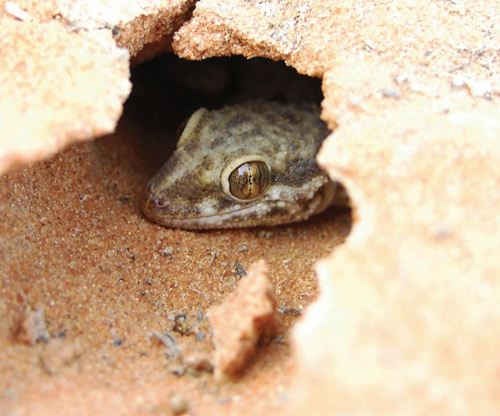
Photo by John M. Regan
Baluch rock geckos (Bunopus tuberculatus) can often be found in or out of Saudi homes.
Getting into the desert is easy. King Fahd Highway runs through Riyadh and will get you out into the wilderness in short order. A word of warning about driving: It is dangerous, very, very dangerous! In my experience, Saudi drivers appear to be utterly reckless and pay no attention whatsoever to speed limits, stops signs or traffic signals. Do not think that because you have driven in New York or Boston that you are prepared. The hazards in our big cities are nothing compared to Riyadh.
For sightseeing and herping in the Riyadh area, two locations are in the absolute must-see category: Thumamah and the Tuwayq Mountains. Thumamah is a Saudi national park that is an intriguing complex of cliffs, deep wadis and hidden valleys. In addition to being fertile herping grounds, Thumamah is a fossil hunter’s dream. Entire hillsides are comprised of the fossilized remains of coral, shells and sponges. Plush Bedouin-style tents are available for overnight stays. The Tuwayq Mountains, also known as the “Edge of the World,” is an astounding ridge of desert cliffs that stop abruptly and overlook a desert plain that seems to go on to infinity. Overnight stays are possible, but bring a tent or sleep in your vehicle.
I was fortunate enough to spend a year in Saudi Arabia near Riyadh. Located approximately in the middle of the country, about 200 miles from the Persian Gulf, Riyadh is known more for its strict adherence to Islamic practice, conduct and dress than its nightlife. A favored tourist attraction it is not. But wildlife is another story. The Riyadh Escarpment, a dramatic curving line of spectacular desert cliffs, runs from north to south along the west side of the city. The scenery is stunning and the fauna in the area is just as dazzling. A single day’s outing reveals everything from camel spiders to baboons. Wolves and hyenas prowl; owls, falcons and eagles soar. Reptiles abound.
The Lizards of Saudi Arabia
But lizards rule. Geckos colored from shades of pink to white run about inside and outside of homes, and they inhabit every crack and crevice of backyards by the dozens. In the desert, the supremacy of lizards is even more evident. In fact, the lizard population is so large that a dedicated observer can soon learn to gauge the temperature of the day simply by identifying the species of lizard that happens to be out at a particular time. It is as though the lizards have taken over the role of rodents in this austere climate.
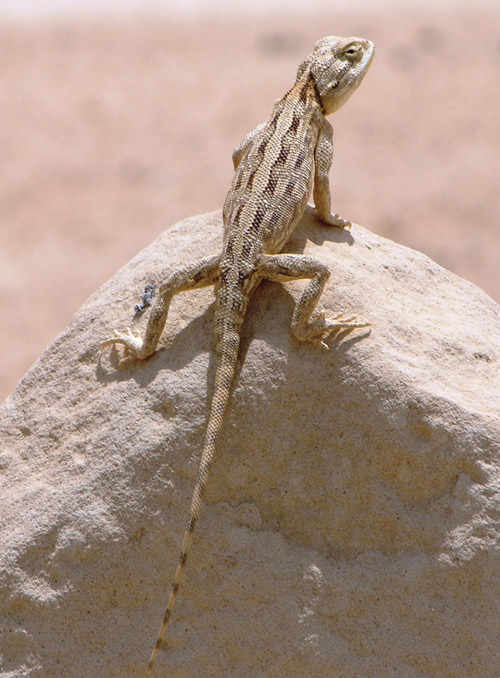
Photo by John M. Regan
Agama blandfordi are fantastically striped lizards that spend much of their time basking.
Geckos and agamids boast the largest variety of species, with the nod toward sheer numbers going to the geckos. Agamids, however, hold the size title. The largest and most famous of the Saudi agamids is the Egyptian uromastyx (Uromastyx aegyptia), also known as the dhub. With an adult length of 2 feet and a hefty 7- to 10-pound weight, the Egyptian uromastyx is the largest lizard species in Saudi and the most well known. They have long been a favorite at the Saudi dinner table. Bedouin desert dwellers are experts at smoking the reptiles out of their den and making a snack out of the lizard’s tail.
Those countless years of hunting have made the Egyptian uromastyx a very wary animal. Despite their size and squat appearance, they are extraordinarily fast and race to their burrow at the first inkling of danger. Catching one in the open is not an easy task. Finding them, however, is hardly a challenge. As the morning heat rises to about 90 degrees — cool by Saudi standards — the Egyptian uromastyx begin to emerge. They are so large and their burrows so distinctive that they are easy to see even when you’re rolling along at a moderate speed in a car. Their resemblance to prairie dogs is remarkable. Like prairie dogs, they are plant eaters. These stout lizards normally exhibit a dull desert-beige color, but in the spring, females display their finery and show off a beautiful variation of vivid yellow-and-black mating colors.
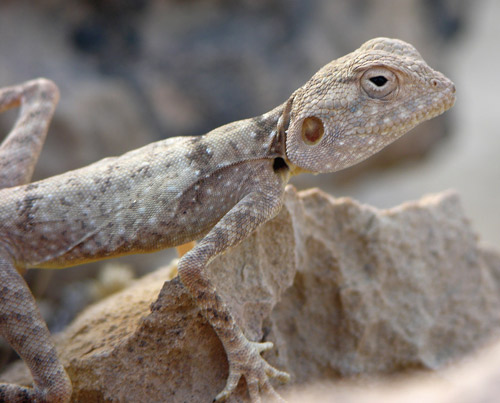
Photo by John M. Regan
Spotted toad-headed agamas (Phrynocephalus maculatus) prefer more moderate heat.
Another large agamid is Agama blandfordi. Bearing a marked resemblance in color and body type to bearded lizards, A. blandfordi reaches 10 inches in length and is just as noticeable a part of the desert landscape as the Egyptian uromastyx. Yet unlike the easily spooked Egyptian uro, these agamids are extraordinarily approachable. Their distinctive profiles grace exposed rocks, dirt mounds and scrub brushes as they calmly bask during the hottest part of the desert day. Perhaps this is the key to their approachability — they simply aren’t used to seeing other living things stirring in this heat. Photographing an A. blandfordi is as easy as driving your vehicle up to its basking rock and clicking the shutter. They can be approached on foot just as easily.
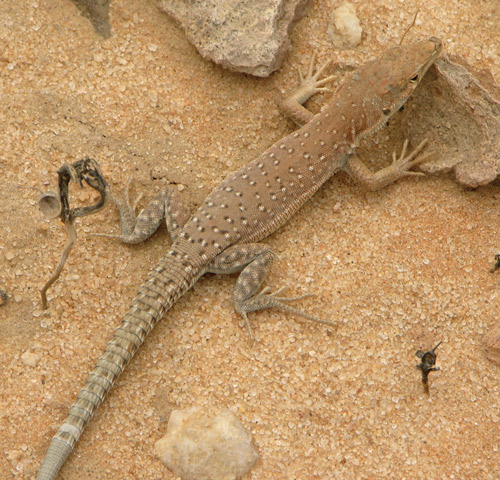
Photo by John M. Regan
A small, extremely hardy and common lizard found throughout the Middle East and into central Asia, the small-spotted lizard (Mesalina guttulata) has a tolerance for a wide variety of temperature extremes
Although A. blandfordi initially appears as a lizard-shaped extension of light-gray rock, a closer look reveals unique wavy patterns of long, dark bands that run the entire length of the animal’s body. At the base of the lizard’s tail, the stripes are interrupted by brown-gray bands. The legs and feet, right down to the animal’s claws, also display this classic camouflage strategy.
Egyptian uromastyx excepted, this nonchalance in the presence of humans seems to be the case with many of the agamid species in the area. The smaller and much prettier spotted toad-headed agama (Phrynocephalus maculatus) prefers rocky landscapes in more moderate heat. These slender lizards often sit very still and allow the photographer to belly crawl all around while snapping close-up after close-up.
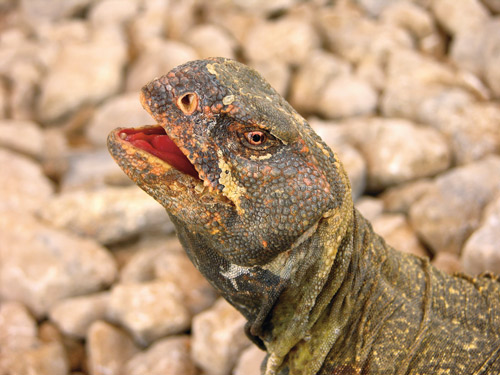
Photo by John M. Regan
Despite its size, the Egyptian uromastyx (Uromastyx aegyptia) is a fast lizard that is difficult to catch
On the other end of the size scale are a number of small, American-anole-shaped lizards that inhabit a variety of desert niches. The delicately designed Hadramaut sand lizard (Mesalina adramitana) stretches out to just 2 inches. This diminutive reptile is a marvelous example of adaptation to extreme conditions. They are most common in areas of small, pancake-shaped rocks devoid of vegetation or anything approaching moisture. No bigger than a medium-sized dragonfly, this little lizard comes out at nearly the height of midday heat. Fast and perfectly camouflaged in sandy beige, it is a difficult animal to spot. At first you think the heat and bland terrain are playing tricks on your eyes. Eventually you realize that those tiny, light-brown flickers in your peripheral vision are actually this small lizard. The obvious food source for the sand lizard is small insects, while there are several Saudi scorpions that will just as easily make a meal out of the sand lizard.
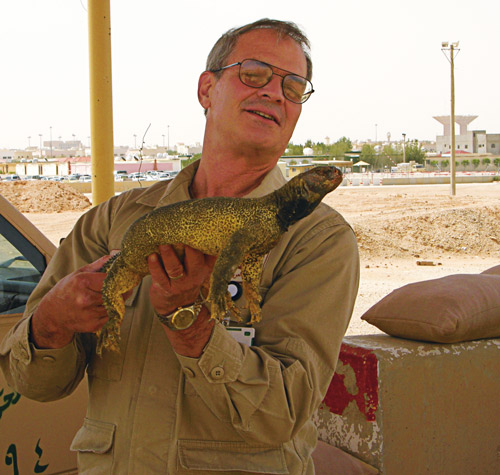
The author holds a female Egyptian uromastyx (Uromastyx aegyptia) displaying mating colors.
Another small, slender lizard is the colorful yellow-headed desert lacerta (Eremias fasciata). Widespread throughout the area and into Central Asia, this tiger-striped and leopard-spotted lizard has adapted itself to a huge variety of climates and habitats. About the time that the big Egyptian uros retire back into their cool underground homes, the yellow-headed desert lacertas emerge, and often in great numbers. It is an unusual trek into the desert when at least a dozen are not encountered; normally there are far more. In some places, the herp enthusiast must take care not to step on the little fellows. Vigorous burrowers, yellow-headed desert lacertas actually “sand swim” for short distances to escape danger.
Species with a size and personality ideal for the collector are the fringe-toed lizards. Schmidt’s fringe-toed lizard (Acanthodactylus schmidti) is the most striking. This is a beautifully colored reptile that displays a light-brown, almost-orange back richly speckled with white scales. Schmidt’s fringe-toed lizard is about 7 inches long and distinguished by an exceptionally long fourth toe on the foot of each rear leg from which protrude a number of comblike, pointed scales. Although this trait is not uncommon in desert lizards, it is especially pronounced in this species. Fringe toes are active and interesting to observe as they meticulously inspect their territory. When prey is spotted, the lizard instantly goes rigid. Suddenly the tail quivers violently as though anticipating the kill. With a flashing strike, the drama is over and the fringe toe continues its explorations.
Saudi Arabian Geckos Everywhere
The lizards most noticeable to Saudi Arabian inhabitants are the geckos. Throughout the desert and in and around humans, the ubiquitous geckos have made themselves at home. The geckos of Saudi have a behavior that sets them apart from their cousins — they do not burrow. This time-honored adaptation to the broiling Saudi sun is casually ignored by the geckos, who prefer to hide under rocks, debris, trash, cracks and crevices. They simply are not into digging.
Perhaps the most common is the Baluch rock gecko (Bunopus tuberculatus). Ranging in color from dull brown to a beautiful pink hue, this gecko is at home in or out of the house.
At the other end of the beauty scale is the rough-tailed gecko (Cyrtopodion scaber), which might be more appropriately named “the ugly gecko.” Light to dark gray with an oddly elongated body, the rough-tailed gecko will never win a best-looking lizard contest. In Saudi Arabia, they live near humans but not with them. Rough tails are found in abundance alongside homes and in backyards, old buildings and dry, rotted trees.
Saudi Arabia Travel Tips
Do not go into the desert without a four-wheel-drive SUV or Land Rover. Although most of the Saudi desert is actually rocky terrain, large patches of soft sand and deceptive surfaces are everywhere. It is easy for the unfamiliar driver to get stuck.
Bring plenty of water. You’ll never have enough. If you do not have a GPS, get one. And bring along a map and compass. A GPS can malfunction or lose signal. The slightest wind kicks up dust that quickly blots out landmarks. It is very easy to get lost. Wear a large “boonie” hat (military-type hat) to protect your head and light, loose-fitting clothes that permit air breezes to penetrate and cool your skin. Drink water constantly. Get used to the desert before straying too far. Stay in familiar territory.
Adhere to Saudi customs! No alcohol. No pork. Ladies must wear an “abaya,” the long hooded gown, when outside of their living quarters, and they are not permitted to drive. You can get away with Western-style apparel in remote desert areas, just be careful. The Saudis are generally lenient with Westerners, but they are not afraid to jail you or rudely eject you from their country for flouting their restrictions.
From the villa courtyard to the severe, otherworldly beauty of the desert, Saudi Arabia is a fascinating country for the herper. The year I spent there was all too short, but the memory of it is burned into my heart like the desert sun. Go and visit this wonderful place. You’ll see an extraordinary array of wildlife and landscapes that will haunt your memory — and a lot of lizards.


